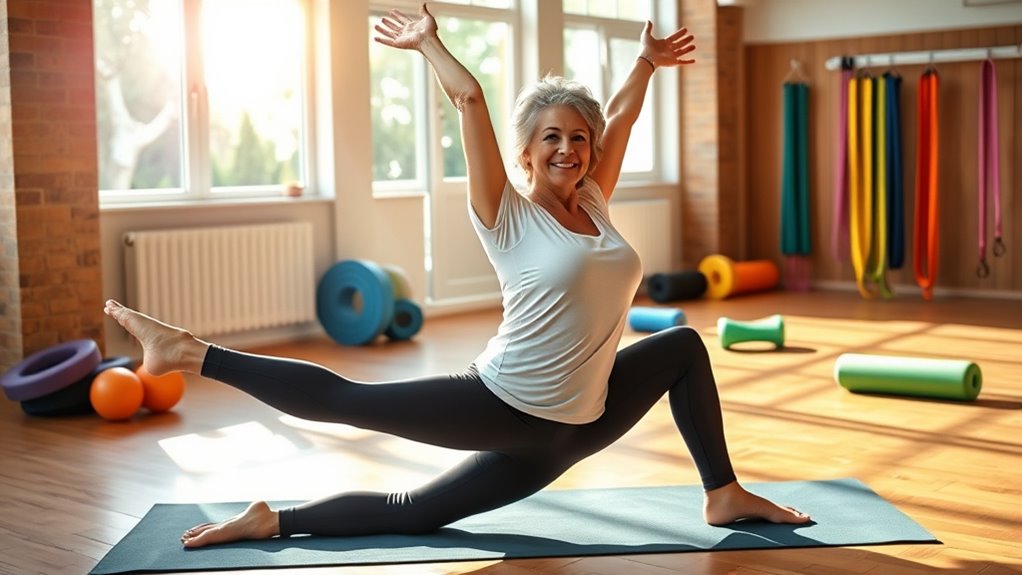To improve mobility and flexibility over 40, focus on gentle daily stretching, joint-supportive exercises like shoulder rolls and ankle circles, and practices like yoga or tai chi that promote mindful movement. Stay hydrated, eat nourishing foods rich in omega-3s and antioxidants, and keep active to strengthen muscles and stabilize joints. Consistency is key, and maintaining healthy habits can help you move comfortably and confidently for years to come. Keep exploring ways to optimize your movement and health.
Key Takeaways
- Incorporate daily gentle stretching routines to gradually enhance flexibility and joint mobility.
- Engage in activities like yoga or tai chi to improve balance, posture, and overall movement.
- Maintain proper hydration and consume anti-inflammatory nutrients to support joint health.
- Strengthen muscles around joints to enhance stability and reduce stiffness.
- Practice consistent movement and healthy habits for long-term mobility and independence.

As you age past 40, maintaining mobility and flexibility becomes crucial for overall well-being and quality of life. One effective way to do this is by establishing consistent stretching routines. Incorporating regular stretching helps keep your muscles elongated and your joints moving freely, which is essential as natural aging can cause stiffness and reduced range of motion. When you dedicate time each day to stretch, you promote better circulation, reduce muscle tension, and prevent the tightness that often accompanies aging. These routines don’t need to be lengthy; even 10-minute sessions focusing on major muscle groups can make a noticeable difference. It’s important to listen to your body and avoid pushing into pain, but gently stretching to the point of mild tension can gradually improve your flexibility.
Your joint health is closely tied to your ability to stay active and mobile. As you get older, cartilage can wear down, and synovial fluid production may decrease, leading to joint discomfort or stiffness. To support joint health, you should include movements that promote joint lubrication and mobility. Gentle stretches, such as shoulder rolls, ankle circles, and hip openers, help keep your joints functioning smoothly. Strengthening the muscles surrounding your joints through low-impact exercises complements stretching routines and offers additional stability. Remember, maintaining healthy joints isn’t just about avoiding pain; it’s about ensuring you can move confidently and comfortably every day. Incorporating joint-supportive activities can further enhance your joint health and overall mobility.
Supporting joint health with gentle stretches and strength exercises keeps you moving confidently every day.
In addition to stretching routines, consider integrating activities like yoga or tai chi into your routine. These practices emphasize mindful movements and flexibility, which can enhance joint health and prevent injuries. They also promote balance and coordination, reducing the risk of falls—a common concern as you age. Consistency is key; the more regularly you stretch and move, the better your body adapts and maintains its mobility. Over time, you’ll likely notice improvements in your posture, reduced stiffness, and increased ease of movement.
Finally, don’t overlook the importance of proper hydration and nutrition to support joint health. Drinking plenty of water helps keep your joints lubricated, while foods rich in omega-3 fatty acids, antioxidants, and vitamins C and D can reduce inflammation and promote tissue repair. Incorporating natural elements like plants and water features into your environment not only enhances your space aesthetically but also encourages a calming mindset that supports overall health. An active lifestyle that includes consistent movement and healthy habits can significantly impact your long-term mobility. By combining these lifestyle choices with targeted stretching routines, you create a well-rounded approach to maintaining flexibility and mobility well into your later years. Staying proactive now ensures you’ll enjoy a more active, comfortable, and independent life in the years to come.
Frequently Asked Questions
Are There Specific Exercises Suitable for Beginners Over 40?
If you’re starting out, there are plenty of gentle stretches and beginner routines suited for you. These exercises help build strength and flexibility gradually without overstraining your muscles. Focus on activities like seated stretches, yoga poses, or gentle cardio. Remember, consistency is key, and always listen to your body. Starting slow with simple routines will set a solid foundation for improving mobility and flexibility over time, especially after 40.
How Often Should I Perform Mobility Routines Weekly?
You should aim to perform mobility routines about 3 to 5 times a week, depending on your fitness level. Incorporate stretching techniques to enhance flexibility and use mobility tools like foam rollers or resistance bands to target tight areas. Consistency is key, so listen to your body and avoid overdoing it. Regular sessions help improve your movement, reduce stiffness, and keep you active and healthy.
Can Improved Flexibility Help Prevent Age-Related Injuries?
Getting a head start on joint health and muscle elasticity can make a big difference, so yes, improved flexibility definitely helps prevent age-related injuries. When you keep your muscles and joints supple, you’re less likely to get hurt from falls or strains. Stretching regularly keeps your body in tune, and it’s the kind of groundwork that pays off in the long run, making everyday movements safer and smoother.
What Are Common Mistakes to Avoid When Stretching?
When stretching, avoid common mistakes like believing stretching myths that suggest you should stretch to the point of pain. Always warm up first to prevent injury, and don’t bounce during stretches, as this can cause strains. Focus on gradual, controlled movements to promote injury prevention. Remember, stretching isn’t about pushing limits but about improving flexibility safely; rushing or overstretching can do more harm than good.
How Does Diet Influence Mobility and Flexibility?
Ever wonder how your diet impacts your flexibility? Nutritional strategies play a pivotal role, providing essential nutrients that keep your muscles and tissues healthy. Dietary supplements can support joint lubrication and reduce inflammation, enhancing mobility. Neglecting proper nutrition might slow down your progress or cause setbacks. So, stay curious—by fueling your body right, you’re actively investing in better flexibility and movement every day.
Conclusion
By focusing on daily movement and stretching, you can markedly enhance your mobility and flexibility after 40. Did you know that regular activity can reduce joint stiffness by up to 30%? Embrace gentle exercises like yoga or walking to stay limber and active. Remember, consistency is key—making small, daily efforts will keep you moving comfortably and confidently for years to come. Stay motivated and enjoy the freedom that improved mobility brings!









